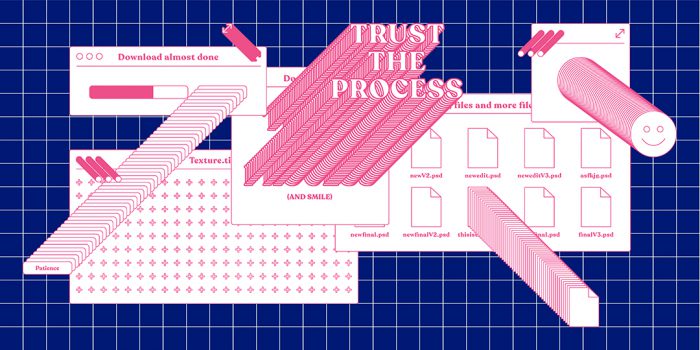How to Make a Graphic Design Invoice: 9 Expert Steps to Follow
Freelancing as a creative professional gives you the opportunity to earn more money than you would as an employee. Often, a LOT more money. But the catch is, that money doesn’t arrive in a timely manner like it does when you’re on staff. In fact, cash flow can be a real issue for freelancers, particularly at the start of their career. You can spend months, sometimes several months, waiting to be paid, and that’s not fun for anyone. The good news is, you can largely avoid running short of cash by following good invoicing practices.
All of our teachers at Shillington are professional designers and illustrators themselves, so they’ve got a lot of collective experience in this area. Read on as they share their tips on how to invoice effectively and never hit that overdraft limit as a result.
1. Make your invoice look professional
In theory, it should make zero difference what your invoice looks like, as long as it contains the correct information. In practice, it can actually matter.
Think about it: accounting staff are humans too. They are typically overloaded with work, and you can easily imagine a scenario when it’s the end of the week, their eyes are tired, and they’re presented with a badly designed invoice with a cluttered and confusing layout.
With a deep sigh, they tell themselves they’ve done enough work today, and they’ll deal with it after the weekend. But then Monday morning rolls around, and they’re off sick. Tuesday is full of meetings; then, when they’re back at work on Wednesday, they’re distracted by five days’ worth of emails.
Had your poorly designed invoiced not presented such a visual challenge on Friday, it would have been dealt with there and then. So it’s vital to make invoices look professional, either by designing your own or using an online accounting tool like Xero or FreeAgent.
So what does ‘professional’ look like in practice? Cathy Sison, Shillington New York Teacher advises:
“Keep it simple and clear. There’s no need to over-design it, but keep it on brand.”
“Just because you’re a designer doesn’t mean your invoice has to be a masterpiece,” adds Bonnie Eichelberger—a teacher at Shillington’s Melbourne campus. “The clearer and simpler it is, the easier it will be for clients to pay you. In fact, using the default invoices generated from your software, if you have it, can be more practical because it will be easier to keep track of which invoices you have sent.”
2. Make your invoice comprehensive
As well as being cleanly designed, it’s also vital that your invoice include everything the client needs to know.
If it does, your invoice stands a good chance of being processed quickly and efficiently. If it does, it may get passed around different accounts staff, put it a ‘deal with later’ pile, and ultimately get lost in the system.
Typically, an invoice should include your client’s own job reference number or code, if they have one. This might be called a purchase order, job number, or something similar. Also include the title of the project or a description of the work, including hours and dates if relevant. And, of course, the amount your client needs to pay you and details of the bank account it needs to be paid into. Finally, your full name and address, telephone number and email address.
Beyond this, Cathy suggests: “It’s a good idea to break down what you’re delivering to the client in the invoice, so they’re educated in what you’re producing. However, unless you’re being paid by the hour, don’t put your hourly rate on your invoice: keep that to yourself!”
Importantly, there may be extra information the client needs to be included, so it’s always worth checking with them first. There are also different requirements in different countries and territories, so do your research when you’re working for global clients.
Missy Dempsey, Shillington Sydney teacher, offers a good example. “For an invoice to be legit in Australia, it must have your ABN (Australian Business Number), your trading or business name, the date issued, and goods or services exchanged,” she explains.
“It must also include the company or person’s ABN and trading name. If you’re not registered for GST (Goods and Services Tax), the invoice must state that it does not include GST in writing, or have a line item where GST is shown as 0.”
3. Break down large sums
It’s great to get a big project as a freelancer. But if you’re waiting for it to end before invoicing, that can cause major problems for cash flow. “So always ask for a percentage of the invoice first, to lock in the job,” advises Cathy.
Bonnie adds:
“For larger or longer-term projects, it’s best to break down the total sum into instalments that are noted on your quote.”
She suggests you might break this into:
- A deposit (min 25%), due before you start the project
- Instalment 2, due at stage 2 (e.g. concept delivery)
- Instalment 3, due at stage 3
- Final instalment, due before the final artwork is supplied.
4. Set your payment terms
While large organisations often have standard payment terms, smaller clients may not. So it’s a good idea to state this on your invoice.
“Set short standard payment terms – for example, seven days – to ensure you have good cash flow,” advises Spencer Harrison—Shillington Melbourne teacher. “You may need to be flexible for larger clients that have 30 days standard, though.”
“Either way, ensure the due date is very clear on the invoice. Place it large and prominent, near the payment amount.”
5. Chase late invoices immediately
If your invoice is not settled on the day it’s due, then don’t hang around. “Send a reminder the day after your invoice is due” advises Spencer.
“Polite pester power is a good way to get paid.”
Make your message short and sweet. “Something like, ‘A friendly reminder that my invoice was due for payment today…’ normally does the trick. But if you get no response, follow up with a phone call and don’t feel embarrassed about asking for the money. You did the work, and you’re entitled to be paid for it!”
Are you still getting blanked? “If you still aren’t getting paid after several polite reminders, you can get firmer,” says Spencer. “For example, you might hold back on sending final artwork or consider a more strongly worded letter from a lawyer.”
6. Build a relationship with Accounts
When freelance payments are seriously late, it’s sometimes because the client is trying to stiff you or has financial troubles of their own and can’t afford to pay. But the vast majority of the time, that’s not the case. It’s far more likely, especially in large organisations, that your invoice is simply ‘stuck in the system’ and being held up by bureaucracy.
For this reason, it can be hugely helpful to strike up a friendly email relationship with the person in accounts dealing with your invoices.
Don’t go overboard, but should they add little personal details to their emails, such as “I won’t be in on Friday because I’m at a wedding”, then make sure you add a friendly “How was the wedding?” in your next email, and go from there.
You don’t have to become best friends forever, but the human touch can go a long way to resolving seemingly intractable problems.
7. Create a system that works for you
It might sound ridiculous, but in practice, many freelancers fail to get paid for work because they’ve simply forgotten about it. So it’s vital to keeping track of all your paid and unpaid invoices in an organised and systematic manner, as well as making them easily searchable at a later date.
In short, you need to create a system that works in a way your brain finds easy.
This might, for example, involve filing invoices in a properly named folder in the cloud, dating each invoice, so they’re easy to find, and including the client’s name in the filename: for example, ’21-04-22 Name of Client’.
Spencer recommends you also: “Set up reminders—a week before, and the day the invoice is due, send email reminders that payment is expected. Some tools like Xero and FreeAgent can do this automatically for you.”
Bonnie adds a further suggestion: “Make a habit of doing regular admin. For example, the first of every month could be an accounts day.”
8. Set aside money for tax
Cashflow problems aren’t just caused by late payments. There’s also that dreaded tax bill, which can instantly drain your bank account and send you into the red.
So once you get paid, don’t forget to always set aside some money for tax. And be aware of exactly how much this needs to be.
For example, if you’re in your first year of freelancing in the UK, you have to save a little extra because the government also taxes you on the income you’re predicted to make the following year.
“I set aside 30% of every invoice for tax,” says Spencer. “And I put it in a separate bank account that I can’t access easily, so I don’t spend it!”
9. Get a good accountant
Although the advice we’ve shared will get you a long way, there will be specific considerations relating to your sector, country and region that are beyond the scope of this article.
For this reason, Bonnie recommends you:
“Find a good accountant and ask them all your questions! There are creative/freelance-specific accountants who know some great tips and tricks to lodge your specific return.”
“If you find a really good one, they are often there for advice all year round, not just at tax time.”
Cathy agrees. “Taxes can be really hard, but if you invest in an accountant, you won’t be missing anything. An accountant is also great if you’re not a numbers person: leave it up to someone who knows what they’re doing!”
Artwork by #ShilloMEL Teacher Kim Melvin
Hope this will help you on your way to getting paid promptly and properly. Want to know more about a career in graphic design? Check out our Ultimate Graphic Design Career Guide and some amazing tips for updating your graphic design portfolio. Not a graphic designer yet? We can help with that too! Learn more about studying graphic design at Shillington and become a graphic designer in three months full-time or nine months part-time.
Want to win some amazing prizes and stay in the loop with all things Shillington? Sign up to our newsletter to automatically go in the draw.







